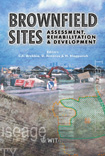Biological Degradation Of PCBs In Soil. A Kinetic Study
Price
Free (open access)
Transaction
Volume
55
Pages
Published
2002
Size
237 kb
Paper DOI
10.2495/BF020531
Copyright
WIT Press
Author(s)
M. A. Manzano, J. A. Perales, D. Sales & J. M. Quiroga
Abstract
In this paper a kinetic study is made of the biodegradability of Aroclor 1242 in sandy soil employing a mixed culture of acclimatized bacteria. The assays were done in stirred tank reactors, and the biodegradation process was monitored by High Resolution Gas Chromatography (HRGC) with Electron Capture Detector. These results are supported by other indirect measurements and indicators of the existence of microbial degradation process, as well as the parameters for the control of the process. The biodegradation occurred as a first order process and it proved most effective in respect of dichlorinated (100% removal), followed by trichlorinated (92%) and tetrachlorinated biphenyls (24%). 1 Introduction Awareness of the toxicity of PCBs has led to increased research into the development of PCB waste treatment technology. Although incineration is currently the most frequently used method of dealing with waste containing a high concentration of PCBs, waste products containing a large proportion of inert material such as soils and sediments require other alternatives [1]. One of the options for this type of waste are biological treatments, made attractive by their low cost and operative simplicity. The aim of this research has been to study the kinetic of the aerobic biodegradation of PCBs adsorbed to soil particles by employing a mixed culture of acclimatized bacteria.
Keywords




